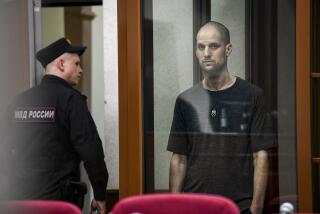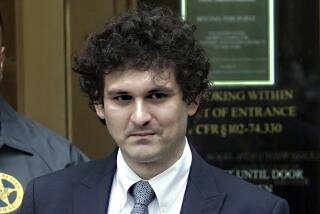Goldman has an unexpected ally in court: federal prosecutors
- Share via
Reporting from New York — Goldman Sachs, the most powerful firm on Wall Street, makes an unlikely victim.
That, however, is the role that the bank has played over the last two weeks in a Manhattan courtroom, where prosecutors have argued that Sergei Aleynikov, a skinny, bespectacled former computer programmer at Goldman, stole valuable computer code from the bank before moving to a start-up firm that was trying to build its own trading operations.
Although the code in question was a mere 32 megabytes — less than a 10th of what fits on a data CD — Goldman executives have said it was a central cog in their high-frequency trading operations, a lucrative division at one of the most profitable companies in the world.
The programs in question worked to ferret out inefficiencies in the stock markets and then trade to take advantage of them. Goldman executives told investigators that if another company had obtained the code, its own ability to profit “would be significantly diminished.”
Goldman turned up Aleynikov’s actions on its own but turned the case over to federal authorities for prosecution.
“He knew what he was doing would injure Goldman Sachs,” the government prosecutor, Rebecca Rohr, said during her closing statement Thursday.
Aleynikov’s lawyers said that he took the code but did not break any federal laws in doing so.
The sight of federal prosecutors arguing Goldman’s case is an unexpected one right now.
For much of the last two years, Goldman has been the subject of relentless public scrutiny for its success in profiting from the financial crisis only a short time after it played a central role in several of the deals that helped precipitate the crisis.
But while critics of the company have waited in vain for charges to be brought against Goldman executives, the government has worked closely with the firm in the Aleynikov case to protect its trade secrets.
If Aleynikov had succeeded, Rohr argued Thursday, “Goldman could have lost market share to a new competitor.”
The trial has cracked open a window onto one of the most successful and secretive firms on Wall Street, and onto the enigmatic electronic trading desks that are accounting for ever larger proportions of profits being made at Goldman and across the financial world.
One indication of the high stakes came when government prosecutors asked, on behalf of Goldman, that certain portions of the trial be closed to the public. The judge consented.
High-frequency traders are now estimated to account for more than two-thirds of all stock trading, a sharp jump from even a few years back. These traders are responsible for industry-wide revenue that is conservatively estimated to be upward of $8 billion annually.
Aleynikov is the second programmer accused of stealing computer code from a big bank to go on trial this year. The first ended in a guilty verdict. Aleynikov’s jury is now in deliberations.
The 25-member high-frequency-trading team that Aleynikov worked with at Goldman was responsible for $300 million in profit last year, prosecutors said.
A witness called by the prosecutors compared the trading platform to race car driver Jimmie Johnson: “This thing was a hot rod, built for speed,” he said.
In the spring of last year, Chicago start-up firm Teza looked to lure Aleynikov away from Goldman to help develop its own trading platform, and offered to more than triple his salary to $1.4million.
On the evening of Aleynikov’s last day at Goldman, on June 5, 2009, Aleynikov sat at his desk in Goldman’s Manhattan headquarters and encrypted bits and pieces of Goldman’s trading software before transferring them to an online server in Germany, according to both sides.
Both sides agree that later, at home, Aleynikov downloaded those files onto his personal laptop computer and took that with him when he traveled to visit his new employer. Upon returning to Newark International Airport, Aleynikov was arrested.
Aleynikov has not denied that he took the files or that in doing so he broke Goldman’s confidentiality rules.
But his lawyers have said that almost everything he took was open source, or free code worked on by a community of programmers.
It was revealed during the trial that much of Goldman’s software was built from a foundation of this free software.
Teza Chief Executive Misha Malyshev testified during the trial that he did not expect or desire that Aleynikov would bring any of Goldman’s program with him.
In a slap at the company, Malyshev said that Goldman had fallen behind many of its competitors in the high-speed trading world and was not worthy of emulation.
“I wouldn’t have taken their code if it was given to me for free,” Malyshev said.
Before starting Teza, Malyshev had overseen a team at Chicago hedge fund Citadel Investment Group that made $1.1 billion in 2008 in the depths of the financial crisis, Malyshev said.
Aleynikov himself did not look the part of the rich banker or the devious hacker. During the trial, he wore ill-fitting suits on his lanky frame and took careful notes on the testimony.
When he was arrested he was living in suburban New Jersey and driving a 2006 Honda Odyssey. He has since been suspended by Teza.
But Goldman executives told investigators that Aleynikov had committed the most serious security breach in the company’s history.
One of Aleynikov’s former supervisors, Adam Schlesinger, said that computerized trading is a high-stakes, zero-sum game in which “if you share what you believe are important aspects of your system with others, that would just help their profitability and hurt yours.”
During the final day of the trial, it was left to the government prosecutor, Rohr, to explain to the jury Goldman’s case and why cases like it matter so much.
“If a program is even a thousandth of a second later,” Rohr said, “your competitor may be able to make the trade before you.”
More to Read
Inside the business of entertainment
The Wide Shot brings you news, analysis and insights on everything from streaming wars to production — and what it all means for the future.
You may occasionally receive promotional content from the Los Angeles Times.










